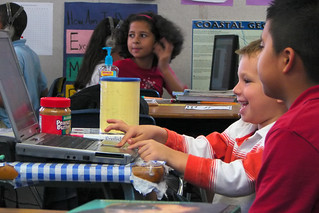I have personally been working with and looking into this matter for many years, be it as a course supervisor, designing, writing and revising tests, probing into the process; be it as an examiner, participating in the final assessment of someone else’s handiwork, with cold analytical eyes, scrutinizing the final product; or even as a curious mind who wonders what it is that we do: Do we test to teach? Do we teach to test? And moreover, what it is that we should be doing?
Anyway, back in January, when Isabela Villas Boas shared a blog post by Nick Provenzano with us, I dared ask her if we could dare… Only to discover that she was the one daring us… In his post, Nick recounts how he spent a semester without his traditional testing system, and how he witnessed high levels of commitment, as well of strong evidence of his students’ skills and knowledge through the use of alternative assignments, essays, projects, and different assessment opportunities.
The discussion was not new to us. We had already been questioning the unquestionable… the effectiveness of our traditional system with our adult students… Why were we able to find students reaching the higher levels – passing test after test, and still not able to use the language? Why were some of our adult students discouraged? How come teachers were feeling frustrated? We decided to turn these difficulties into opportunities for development. The theoretical project had been ready – on paper – for a few months, as Isabella had taken an online program on assessment with Oregon University. All we had to do was “take the leap” and bring it to life. Right now, there are two groups – one Thomas flex 1, and one Prime 1 – being piloted with an alternative assessment system.
This series of posts is an attempt to share what we are trying to do, inviting you into this experience-experiment, summoning your thoughts and encouraging your input.
The THOMAS FLEX 1 Experiment:
In week 3 (of 10), having already worked with most of Unit 1, we wanted to ascertain that the students were able to interact using the following exponents:- What’s your name? My name is…
- How are you? I’m…, and you?
- What’s your telephone number? It’s (numbers 0-9)
- Nice to meet you/Nice to meet you too.
The lesson was designed to build on student’s recently acquired abilities, consolidate them, and finally, invite linguistic output that could be assessed. The procedure was the following:
- Each pair of students received a dialogue cut up into slips. They were asked to put the slips in a logical sequence to make the dialogue.
- With the correct sequence, students were asked to personalize the dialogue, by substituting names and other elements with their own personal information.
- Then, the slips were collected and the teacher elicited the dialogue on the board – leaving blanks in which they would complete with their own names, etc.
- After that, the students were asked to stand up and cocktail, talking to at least three different classmates, using the dialogue on the board as a model. T observed and monitored the exchanges, cleaning the board when most of the students had performed the dialogue at least once.
- Finally, the T called on pairs of students and asked them to perform the dialogue out loud – no model available. As they did so, the teacher filled in an assessment sheet with the following criteria:
- Correct greeting / response to greeting - Yes (2pts.) - Partially (1pt.) - No (0 pt.)
- Asks name correctly - Yes (2pts.) - Partially (1pt.) - No (0 pt.)
- Responds to question about name correctly - Yes (2pts.) - Partially (1pt.) - No (0 pt.)
- Says and responds to “nice to meet you” - Yes (2pts.) - Partially (1pt.) - No (0 pt.)
- Asks and/or answers about phone number - Yes (2pts.) - Partially (1pt.) - No (0 pt.)
This was the end of their first “Oral Assessment Opportunity”. The plan is to have one of these every week, focusing on different skills-areas such as speaking, writing – in which grammar would be either intrinsically embedded, or clearly stated, and also listening and reading – for we see that one of these students’ main difficulty is understanding input, so that they can formulate their own output.
Anyway, we are using the media with one sole purpose: hearing your thoughts. Do you have any ideas we can use in this pilot project? Are there any feelings or thoughts you would like to share? Is there anything in your experience that can add to this experiment? Let’s get this chat started… The ball in on your court!


























